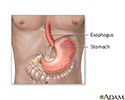Mallory-Weiss tear
Mucosal lacerations - gastroesophageal junctionA Mallory-Weiss tear occurs in the mucous membrane of the lower part of the esophagus or upper part of the stomach, near where they join. The tear may bleed.
Mucous membrane
Mucosa is moist tissue that lines certain parts of the inside of your body. It is in your: NoseMouthLungsDigestive tractUrinary and genital tracts G...

Causes
Mallory-Weiss tears are most often caused by forceful or long-term vomiting or coughing. They may also be caused by epileptic seizures or other less common situations.
Vomiting
Nausea is feeling an urge to vomit. It is often called "being sick to your stomach. "Vomiting or throwing-up forces the contents of the stomach up t...

Coughing
Coughing is an important way to keep your throat and airways clear. But too much coughing may mean you have a disease or disorder. Some coughs are d...

Seizures
A seizure is the physical changes in behavior that occurs during an episode of specific types of abnormal electrical activity in the brain. The term ...

Any condition that leads to violent and lengthy bouts of coughing or vomiting can cause these tears.
Symptoms
Symptoms may include:
-
Bloody stools
Bloody stools
Black or tarry stools with a foul smell are a sign of a problem in the upper digestive tract. It most often indicates that there is bleeding in the ...
 ImageRead Article Now Book Mark Article
ImageRead Article Now Book Mark Article -
Vomiting blood (bright red)
Vomiting blood
Vomiting blood is regurgitating (throwing up) contents of the stomach that contains blood. Vomited blood may appear bright red, dark red, or look lik...
Read Article Now Book Mark Article
Exams and Tests
Tests may include:
-
CBC, possibly showing low hematocrit
CBC
A complete blood count (CBC) test measures the following:The number of white blood cells (WBC count)The number of red blood cells (RBC count)The numb...
 ImageRead Article Now Book Mark Article
ImageRead Article Now Book Mark ArticleHematocrit
Hematocrit is a blood test that measures how much of a person's blood is made up of red blood cells as opposed to plasma. This measurement depends o...
 ImageRead Article Now Book Mark Article
ImageRead Article Now Book Mark Article -
Esophagogastroduodenoscopy (EGD), more likely to be done when there is active bleeding or high-risk for rebleeding.
Esophagogastroduodenoscopy
Esophagogastroduodenoscopy (EGD) is a test to examine the lining of the esophagus, stomach, and first part of the small intestine (the duodenum)....
 ImageRead Article Now Book Mark Article
ImageRead Article Now Book Mark Article
Treatment
The tear usually heals in a few days without treatment. The tear may also be fixed by clips, electrocoagulation, or epinephrine injection that may be done during an EGD. Surgery is rarely needed. Medicines that suppress stomach acid (proton pump inhibitors) are typically given for a short time after to decrease rebleeding.
If blood loss has been large, blood transfusions may be needed. In most cases, bleeding stops without treatment within a few hours.
Blood loss
Bleeding is the loss of blood. Bleeding may be:Inside the body (internal)Outside the body (external)Bleeding may occur:Inside the body when blood le...

Outlook (Prognosis)
Repeated bleeding is uncommon and the outcome is most often good. Cirrhosis of the liver and problems with blood clotting make future bleeding episodes more likely to occur.
Cirrhosis
Cirrhosis is scarring of the liver and poor liver function. It is the last stage of chronic liver disease.

Possible Complications
Hemorrhage (loss of blood)
When to Contact a Medical Professional
Contact your health care provider if you begin vomiting blood or if you pass bloody stools.
Prevention
Treatments to relieve vomiting and coughing may reduce risk. Avoid excessive alcohol use.
Alcohol use
Alcohol use involves drinking beer, wine, or hard liquor.
References
Falk GW, Katzka DA. Diseases of the esophagus. In: Goldman L, Cooney KA, eds. Goldman-Cecil Medicine. 27th ed. Philadelphia, PA: Elsevier; 2024:chap 124.
Katzka DA. Esophageal disorders caused by medications, trauma, and infection. In: Feldman M, Friedman LS, Brandt LJ, eds. Sleisenger and Fordtran's Gastrointestinal and Liver Disease. 11th ed. Philadelphia, PA: Elsevier; 2021:chap 45.
-
Digestive system - illustration
The esophagus, stomach, large and small intestine, aided by the liver, gallbladder and pancreas convert the nutritive components of food into energy and break down the non-nutritive components into waste to be excreted.
Digestive system
illustration
-
Mallory-Weiss tear - illustration
A Mallory-Weiss tear results from prolonged and forceful vomiting, coughing or convulsions. Typically the mucous membrane at the junction of the esophagus and the stomach develops lacerations which bleed, evident by bright red blood in vomitus, or bloody stools. It may occur as a result of excessive alcohol ingestion. This is an acute condition which usually resolves within 10 days without special treatment.
Mallory-Weiss tear
illustration
-
Stomach and stomach lining - illustration
The stomach connects the esophagus to the small intestines and is where the majority of food digestion takes place.
Stomach and stomach lining
illustration
-
Digestive system - illustration
The esophagus, stomach, large and small intestine, aided by the liver, gallbladder and pancreas convert the nutritive components of food into energy and break down the non-nutritive components into waste to be excreted.
Digestive system
illustration
-
Mallory-Weiss tear - illustration
A Mallory-Weiss tear results from prolonged and forceful vomiting, coughing or convulsions. Typically the mucous membrane at the junction of the esophagus and the stomach develops lacerations which bleed, evident by bright red blood in vomitus, or bloody stools. It may occur as a result of excessive alcohol ingestion. This is an acute condition which usually resolves within 10 days without special treatment.
Mallory-Weiss tear
illustration
-
Stomach and stomach lining - illustration
The stomach connects the esophagus to the small intestines and is where the majority of food digestion takes place.
Stomach and stomach lining
illustration
Review Date: 10/30/2024
Reviewed By: Jenifer K. Lehrer, MD, Gastroenterologist, Philadelphia, PA. Review provided by VeriMed Healthcare Network. Also reviewed by David C. Dugdale, MD, Medical Director, Brenda Conaway, Editorial Director, and the A.D.A.M. Editorial team.




